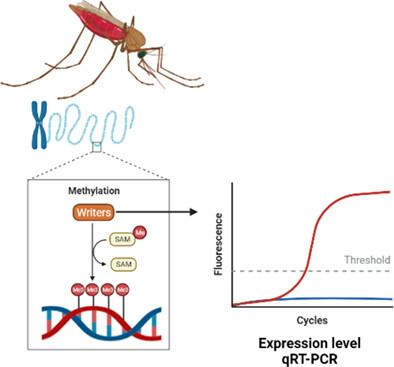Relative expression of key genes involved in nucleic acids methylation in Anopheles gambiae sensu stricto
IF 1.6
3区 农林科学
Q2 ENTOMOLOGY
引用次数: 0
Abstract
In vertebrates, enzymes responsible for DNA methylation, one of the epigenetic mechanisms, are encoded by genes falling into the cytosine methyltransferases genes family (Dnmt1, Dnmt3a,b and Dnmt3L). However, in Diptera, only the methyltransferase Dnmt2 was found, suggesting that DNA methylation might act differently for species in this order. Moreover, genes involved in epigenetic dynamics, such as Ten‐eleven Translocation dioxygenases (TET) and Methyl‐CpG‐binding domain (MBDs), present in vertebrates, might play a role in insects. This work aimed at investigating nucleic acids methylation in the malaria vector Anopheles gambiae (Diptera: Culicidae) by analysing the expression of Dnmt2, TET2 and MBDs genes using quantitative real‐time polymerase chain reaction (qRT‐PCR) at pre‐immature stages and in reproductive tissues of adult mosquitoes. In addition, the effect of two DNA methylation inhibitors on larval survival was evaluated. The qPCR results showed an overall low expression of Dnmt2 at all developmental stages and in adult reproductive tissues. In contrast, MBD and TET2 showed an overall higher expression. In adult mosquito reproductive tissues, the expression level of the three genes in males' testes was significantly higher than that in females' ovaries. The chemical treatments did not affect larval survival. The findings suggest that mechanisms other than DNA methylation underlie epigenetic regulation in An. gambiae.

冈比亚按蚊核酸甲基化相关关键基因的相对表达。
在脊椎动物中,负责DNA甲基化(表观遗传学机制之一)的酶由胞嘧啶甲基转移酶基因家族(Dnmt1、Dnmt3a、b和Dnmt3L)的基因编码。然而,在夜蛾中,只发现了甲基转移酶Dnmt2,这表明DNA甲基化可能对该目物种有不同的作用。此外,参与表观遗传学动力学的基因,如脊椎动物中存在的十-十一易位双加氧酶(TET)和甲基CpG结合结构域(MBDs),可能在昆虫中发挥作用。本工作旨在通过使用定量实时聚合酶链反应(qRT-PCR)分析Dnmt2、TET2和MBDs基因在未成熟前期和成年蚊子生殖组织中的表达,研究疟疾媒介冈比亚按蚊(Diptera:库蚊科)的核酸甲基化。此外,还评估了两种DNA甲基化抑制剂对幼虫存活的影响。qPCR结果显示Dnmt2在所有发育阶段和成年生殖组织中的总体低表达。相反,MBD和TET2显示出总体较高的表达。在成年蚊子的生殖组织中,这三个基因在雄性睾丸中的表达水平显著高于雌性卵巢。化学处理不影响幼虫的存活。研究结果表明,除DNA甲基化外,其他机制是冈比亚表观遗传学调控的基础。
本文章由计算机程序翻译,如有差异,请以英文原文为准。
求助全文
约1分钟内获得全文
求助全文
来源期刊

Medical and Veterinary Entomology
农林科学-昆虫学
CiteScore
3.70
自引率
5.30%
发文量
65
审稿时长
12-24 weeks
期刊介绍:
Medical and Veterinary Entomology is the leading periodical in its field. The Journal covers the biology and control of insects, ticks, mites and other arthropods of medical and veterinary importance. The main strengths of the Journal lie in the fields of:
-epidemiology and transmission of vector-borne pathogens
changes in vector distribution that have impact on the pathogen transmission-
arthropod behaviour and ecology-
novel, field evaluated, approaches to biological and chemical control methods-
host arthropod interactions.
Please note that we do not consider submissions in forensic entomology.
 求助内容:
求助内容: 应助结果提醒方式:
应助结果提醒方式:


